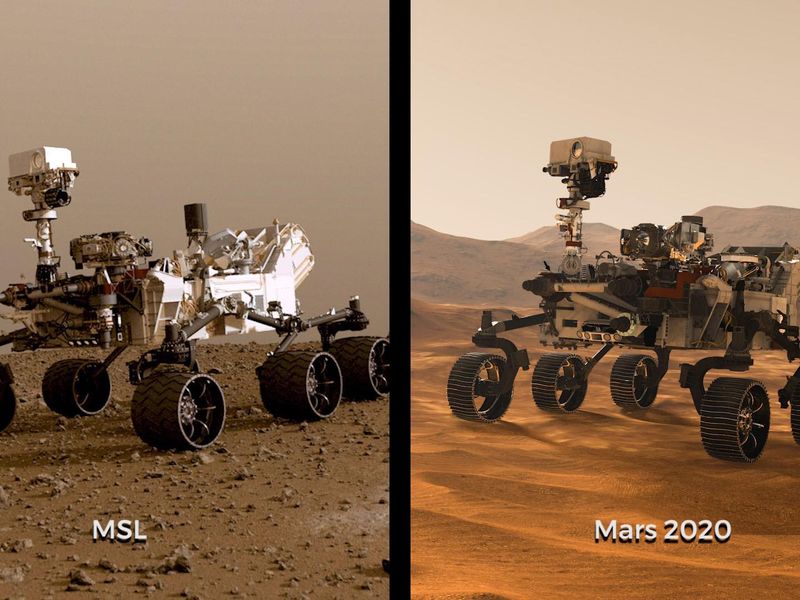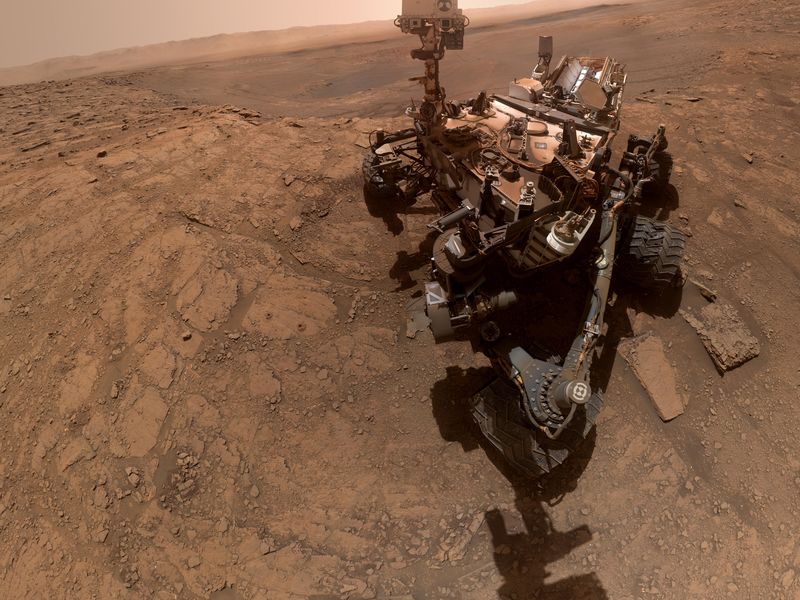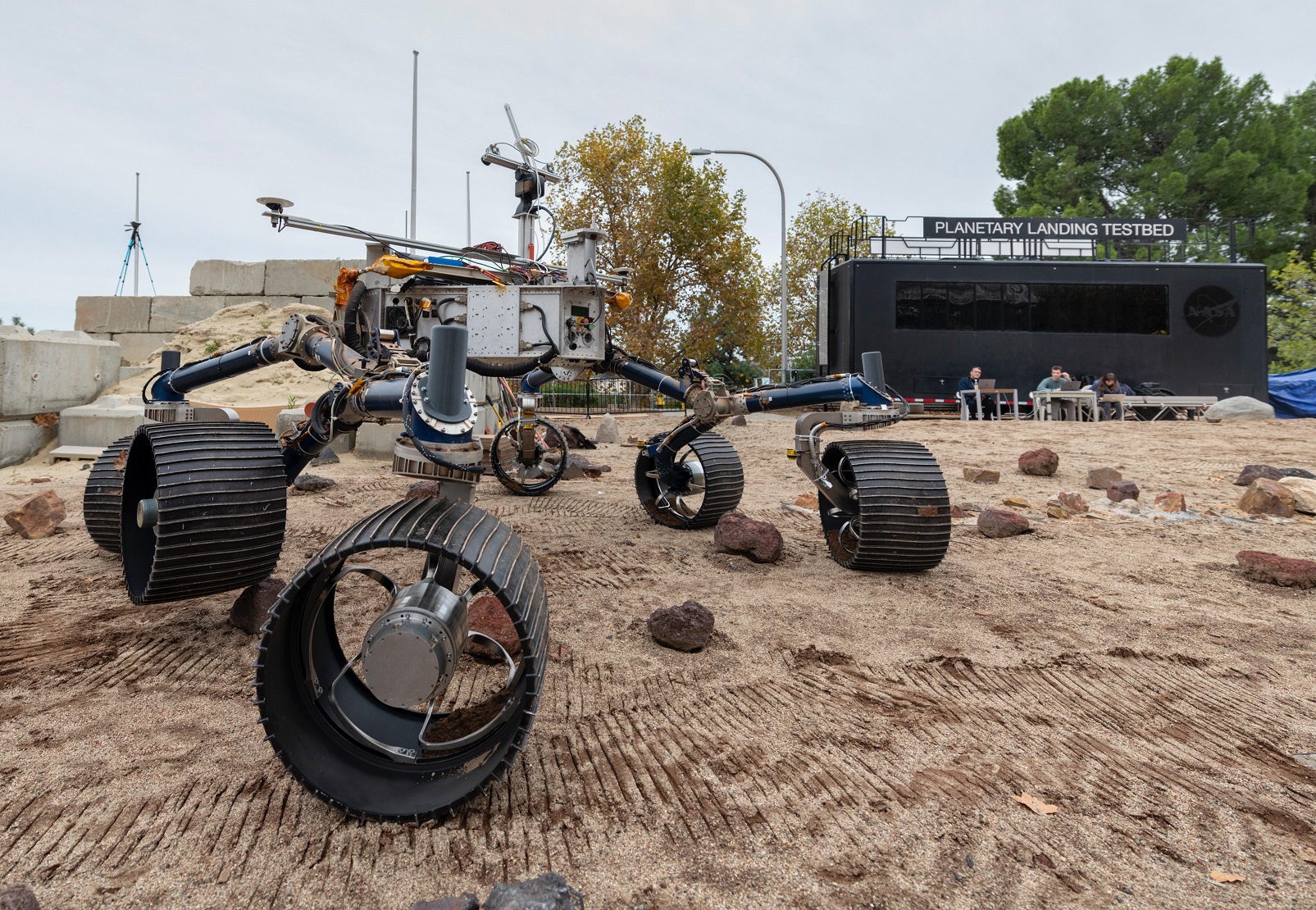

Space
A Tale of Two Rovers: How does Mars 2020 compare to Curiosity?
NASA’s next Mars rover is almost ready to launch. Engineers recently took it for a test spin, before shipping it off to its Cape Canaveral launch site. The six-wheeled rover will blast off this July; once it arrives on Mars, it will scour the red planet for signs of ancient life.
The Mars 2020 rover, which should receive a name very soon, is nearly identical in appearance to its predecessor, the Curiosity rover. After landing on Mars in 2012, Curiosity has spent its time exploring Gale Crater, a 96-mile-wide crater.
It was once the site of an ancient lake and stream system; scientists believe that it may have been able to support life. However, like the rest of the planet’s surface, the area is dry today.

The twin rovers, Spirit and Opportunity landed on Mars in 2004 with one major goal: to follow the water. Right out of the gate, the duo proved that water once flowed on the surface of Mars. But what happened to it?
To answer that question, NASA launched the supersized Curiosity rover to learn more. Since landing in 2012, Curiosity discovered that Gale Crater was once home to an ancient lake billions of years ago and that it could have supported microbial life. The rover is still scouring the crater, hunting for clues as it climbs Mount Sharp, a 3-mile-tall (5-kilometer-tall) peak within the crater — that scientists believe was partially formed by water.
3,760 miles (6,050 kilometers) away, Mars 2020 will explore Jezero Crater, the site of an ancient delta. Here the rover will take the next scientific step: It will look for actual signs of past life, called biosignatures, by analyzing samples of rocks and soil. It will also bag up samples that could be retrieved by future missions and eventually returned to Earth for more in-depth analysis.

Mars 2020 is essentially a souped-up version of the Curiosity rover, but charged with searching for signs of life and collecting samples for eventual return to Earth. The new rover is estimated to cost $1.9 billion dollars and will carry a suite of 7 specialized instruments that will science the hell out of Mars.
But first the rover has to land on Mars. To do so, it must survive a harrowing process known as entry, descent, and landing (aka seven minutes of terror).
To the untrained eye, Mars 2020 looks like an identical copy of Curiosity, but if you look closely, you can tell that the two apart. Building a rover from scratch is extremely difficult and expensive. The folks at NASA built on the success of Curiosity and added new capabilities. A process that enabled more science at a reduced cost.
The beefier Mars 2020 rover is about 280 lbs. (127 kilograms) heavier than its counterpart. That’s because it carries different tools, like a larger drill. This enables the new rover to drill into rocks, extracting rock cores rather than just smashing them.
We all love the epic robot selfies and stunning views of Martian landscapes so of course the new rover will be packing multiple cameras. Curiosity is equipped with 17 cameras; by comparison, Mars 2020 will have 23 that will shoot mostly in color. Additionally, Mars 2020’s Mastcam-Z will film in high definition and be able to zoom.

Mars 2020 will also carry not one but two microphones on its journey so all of us back here on Earth can hear what Mars sounds like. The microphones will record the rover’s landing on Mars, as well as the Martian wind and will listen as the rover zaps scientific targets with its on board laser.
Another design improvement will be the wheels. Curiosity was equipped with aluminum wheels, which have been badly beaten up by the rugged Martian terrain. Sharp rocks have proved to be troublesome, with NASA modifying the rover’s driving plan to ensure Curiosity makes it through its mission. To avoid these kinds of issues, engineers made Mars 2020’s wheels more robust.
“Extensive testing in JPL’s Mars Yard has shown these treads better withstand the pressure from sharp rocks but work just as well on sand,” NASA officials said in a news release.

NASA plans to return to the moon and eventually send humans to Mars. To that end, the Mars 2020 rover will help pave the way for future missions. The rover will carry spacesuit samples to determine how they degrade over time, as well as a subsurface radar instrument that could potentially be used to find buried water ice.
Additionally, an oxygen generator will test technology that future astronauts could use to make their own rocket fuel from the Martian atmosphere.

News
SpaceX shades airline for seeking contract with Amazon’s Starlink rival

SpaceX employees, including its CEO Elon Musk, shaded American Airlines on social media this past weekend due to the company’s reported talks with Amazon’s Starlink rival, Leo.
Starlink has been adopted by several airlines, including United Airlines, Qatar Airways, Hawaiian Airlines, WestJet, Air France, airBaltic, and others. It has gained notoriety as an extremely solid, dependable, and reliable option for airline travel, as traditional options frequently cause users to lose connection to the internet.
Many airlines have made the switch, while others continue to mull the options available to them. American Airlines is one of them.
A report from Bloomberg indicates the airline is thinking of going with a Starlink rival owned by Amazon, called Leo. It was previously referred to as Project Kuiper.
American CEO Robert Isom said (via Bloomberg):
“While there’s Starlink, there are other low-Earth-orbit satellite opportunities that we can look at. We’re making sure that American is going to have what our customers need.”
Isom also said American has been in touch with Amazon about installing Leo on its aircraft, but he would not reveal the status of any discussions with the company.
The report caught the attention of Michael Nicolls, the Vice President of Starlink Engineering at SpaceX, who said:
“Only fly on airlines with good connectivity… and only one source of good connectivity at the moment…”
CEO Elon Musk replied to Nicolls by stating that American Airlines risks losing “a lot of customers if their connectivity solution fails.”
American Airlines will lose a lot of customers if their connectivity solution fails
— Elon Musk (@elonmusk) December 14, 2025
There are over 8,000 Starlink satellites in orbit currently, offering internet coverage in over 150 countries and territories globally. SpaceX expands its array of satellites nearly every week with launches from California and Florida, aiming to offer internet access to everyone across the globe.
Currently, the company is focusing on expanding into new markets, such as Africa and Asia.
News
Tesla hints at Starlink integration with recent patent
“By employing polymer blends, some examples enable RF transmission from all the modules to satellites and other communication devices both inside and outside the vehicle.”

Tesla hinted at a potential Starlink internet terminal integration within its vehicles in a recent patent, which describes a vehicle roof assembly with integrated radio frequency (RF) transparency.
The patent, which is Pub. No U.S. 2025/0368267 describes a new vehicle roof that is made of RF-transparent polymer materials, allowing and “facilitating clear communication with external devices and satellites.”
Tesla believes that a new vehicle roof design, comprised of different materials than the standard metallic or glass elements used in cars today, would allow the company to integrate modern vehicular technologies, “particularly those requiring radio frequency transmission and reception.
Tesla has recently filed a US patent application on integrating RF transparent materials into the roof structure.
“facilitating clear communication with external devices and satellites”
Tesla fleet is getting @Starlink connectivity integration soon. LFG @Tesla @elonmusk… pic.twitter.com/bLa8YtPLd1
— Chansoo Byeon (@Chansoo) December 9, 2025
Instead of glass or metallic materials, Tesla says vehicles may benefit from high-strength polymer blends, such as Polycarbonate, Acrylonitrile Butadiene Styrene, or Acrylonitrile Styrene Acrylate.
These materials still provide ideal strength metrics for crashworthiness, stiffness for noise, vibration, and harshness control, and are compliant with head impact regulations.
They would also enable better performance with modern technologies, like internet terminals, which need an uninterrupted signal to satellites for maximum reception. Tesla writes in the patent:
“By employing polymer blends, some examples enable RF transmission from all the modules to satellites and other communication devices both inside and outside the vehicle.”

One of the challenges Tesla seems to be aware of with this type of roof design is the fact that it will still have to enable safety and keep that at the forefront of the design. As you can see in the illustration above, Tesla plans to use four layers to increase safety and rigidity, while also combating noise and vibration.
It notes in the patent that disclosed examples still meet the safety requirements outlined in the Federal Motor Vehicle Safety Standards (FMVSS).
Starlink integrated directly into Tesla vehicles would be a considerable advantage for owners. It would come with a handful of distinct advantages.
Initially, the inclusion of Starlink would completely eliminate cellular dead zones, something that is an issue, especially in rural areas. Starlink would provide connectivity in these remote regions and would ensure uninterrupted service during road trips and off-grid adventures.
It could also be a critical addition for Robotaxi, as it is crucial to have solid and reliable connectivity for remote monitoring and fleet management.
Starlink’s growing constellation, thanks to SpaceX’s routine and frequent launch schedule, will provide secure, stable, and reliable internet connectivity for Tesla vehicles.
Although many owners have already mounted Starlink Mini dishes under their glass roofs for a similar experience, it may be integrated directly into Teslas in the coming years, either as an upgrade or a standard feature.
Investor's Corner
SpaceX IPO is coming, CEO Elon Musk confirms
However, it appears Musk is ready for SpaceX to go public, as Ars Technica Senior Space Editor Eric Berger wrote an op-ed that indicated he thought SpaceX would go public soon. Musk replied, basically confirming it.

Elon Musk confirmed through a post on X that a SpaceX initial public offering (IPO) is on the way after hinting at it several times earlier this year.
It also comes one day after Bloomberg reported that SpaceX was aiming for a valuation of $1.5 trillion, adding that it wanted to raise $30 billion.
Musk has been transparent for most of the year that he wanted to try to figure out a way to get Tesla shareholders to invest in SpaceX, giving them access to the stock.
He has also recognized the issues of having a public stock, like litigation exposure, quarterly reporting pressures, and other inconveniences.
However, it appears Musk is ready for SpaceX to go public, as Ars Technica Senior Space Editor Eric Berger wrote an op-ed that indicated he thought SpaceX would go public soon.
Musk replied, basically confirming it:
As usual, Eric is accurate
— Elon Musk (@elonmusk) December 10, 2025
Berger believes the IPO would help support the need for $30 billion or more in capital needed to fund AI integration projects, such as space-based data centers and lunar satellite factories. Musk confirmed recently that SpaceX “will be doing” data centers in orbit.
AI appears to be a “key part” of SpaceX getting to Musk, Berger also wrote. When writing about whether or not Optimus is a viable project and product for the company, he says that none of that matters. Musk thinks it is, and that’s all that matters.
It seems like Musk has certainly mulled something this big for a very long time, and the idea of taking SpaceX public is not just likely; it is necessary for the company to get to Mars.
The details of when SpaceX will finally hit that public status are not known. Many of the reports that came out over the past few days indicate it would happen in 2026, so sooner rather than later.
But there are a lot of things on Musk’s plate early next year, especially with Cybercab production, the potential launch of Unsupervised Full Self-Driving, and the Roadster unveiling, all planned for Q1.








